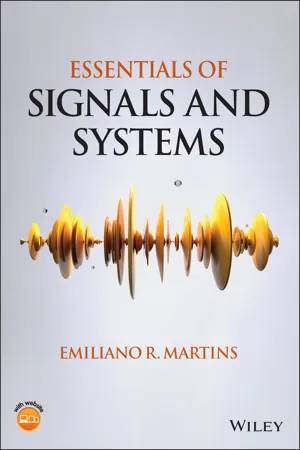
- English
- PDF
- Available on iOS & Android
Essentials of Signals and Systems
About this book
Novel approach to the theory of signals and systems in an introductory, accessible textbook
Signals and Systems have the reputation of being a difficult subject. Essentials of Signals and Systems is a standalone textbook aiming to change this reputation with a novel approach to this subject, teaching the essential concepts of signals and systems in a clear, friendly, intuitive, and accessible way.
The overall vision of the book is that traditional approaches to signals and systems are unnecessarily convoluted, and that students' learning experiences are much improved by making a clear connection between the theory of representation of signal and systems, and the theory of representation of vectors and matrices in linear algebra. The author begins by reviewing the theory of representation in linear algebra, emphasizing that vectors are represented by different coordinates when the basis is changed, and that the basis of eigenvectors is special because it diagonalizes the operator. Thus, in each step of the theory of representation of signals and systems, the author shows the analogous step in linear algebra. With such an approach, students can easily understand that signals are analogous to vectors, that systems are analogous to matrices, and that Fourier transforms are a change to the basis that diagonalizes LTI operators.
The text emphasizes the key concepts in the analysis of linear and time invariant systems, demonstrating both the algebraic and physical meaning of Fourier transforms. The text carefully connects the most important transforms (Fourier series, Discrete Time Fourier Transform, Discrete Fourier Transforms, Laplace and z-transforms), emphasizing their relationships and motivations. The continuous and discrete time domains are neatly connected, and the students are shown step-by-step how to use the fft function, using simple examples.
Incorporating learning objectives and problems, and supported with simple Matlab codes to illustrate concepts, the text presents to students the foundations to allow the reader to pursue more advanced topics in later courses.
Developed from lecture notes already tested with more than 600 students over six years, Essentials of Signals and Systems covers sample topics such as:
- Basic concepts of linear algebra that are pertinent to signals and systems.
- Theory of representation of signals, with an emphasis on the notion of Fourier transforms as a change of basis, and on their physical meaning.
- Theory of representation of linear and time invariant systems, emphasizing the role of Fourier transforms as a change to the basis of eigenvectors, and the physical meaning of the impulse and frequency responses.
- What signals and systems have to do with phasors and impedances, and the basics of filter design.
- The Laplace transform as an extension of Fourier transforms.
- Discrete signals and systems, the sampling theorem, the Discrete Time Fourier Transform (DTFT), the Discrete Fourier Transform (DFT), and how to use the fast fourier transform (fft).
- The z-transform as an extension of the Discrete Time Fourier Transform.
Essentials of Signals and Systems is an immensely helpful textbook on the subject for undergraduate students of electrical and computer engineering. The information contained within is also pertinent to those in physics and related fields involved in the understanding of signals and system processing, including those working on related practical applications.
Frequently asked questions
- Essential is ideal for learners and professionals who enjoy exploring a wide range of subjects. Access the Essential Library with 800,000+ trusted titles and best-sellers across business, personal growth, and the humanities. Includes unlimited reading time and Standard Read Aloud voice.
- Complete: Perfect for advanced learners and researchers needing full, unrestricted access. Unlock 1.4M+ books across hundreds of subjects, including academic and specialized titles. The Complete Plan also includes advanced features like Premium Read Aloud and Research Assistant.
Please note we cannot support devices running on iOS 13 and Android 7 or earlier. Learn more about using the app.
Information
Table of contents
- Cover
- Title Page
- Copyright
- Contents
- Preface
- About the Author
- Acknowledgments
- About the Companion Website
- Chapter 1 Review of Linear Algebra
- Interlude: Signals and Systems: What is it About?
- Chapter 2 Representation of Signals
- Chapter 3 Representation of Systems
- Chapter 4 Electric Circuits as LTI Systems
- Chapter 5 Filters
- Chapter 6 Introduction to the Laplace Transform
- Interlude: Discrete Signals and Systems: Why do we Need Them?
- Chapter 7 The Sampling Theorem and the Discrete Time Fourier Transform (DTFT)
- Chapter 8 The Discrete Fourier Transform (DFT)
- Chapter 9 Discrete Systems
- Chapter 10 Introduction to the z‐transform
- References with Comments
- A Laplace Transform Property of Product in the Time Domain
- B List of Properties of Laplace Transforms
- Index
- EULA